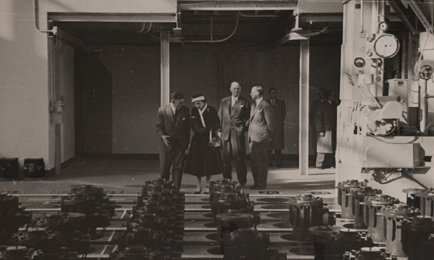Articles
Plugged in: Calder Hall was built to supply the national grid
The world’s first nuclear power plant was opened in 1954 in Obninsk in the Soviet Union. But the first civil nuclear power station was built in the UK, to supply electricity to the national grid. Calder Hall, constructed between 1950 and 1956 on the site that became Sellafield in Cumbria, was designed by a former president of the IMechE, Sir Christopher Hinton, a key member of the UK Atomic Energy Authority (UKAEA).
Hinton was an experienced nuclear engineer and project manager – at only 29 he was made chief engineer for Imperial Chemical Industries. His work in the early 1940s as deputy director-general of the Royal Filling Factory organisation, which dealt with munitions, was crucial in the war effort.
He then became head of the UKAEA’s site at Risley, using his academic and practical experience to further work and research into Britain’s new nuclear infrastructure by building plants for uranium enrichment, fuel rod production, plutonium separation and the nuclear reactors. However, the group lacked the money they needed for all their projects because money was being channelled into other areas for the war effort.
When the UKAEA acquired Calder Hall, it brought Hinton onboard as project manager
and designer.
At the time, the building of the power station was seen as the start of a new era of nuclear power. Sir Edwin Plowden, then chairman of the UKAEA, asserted in the foreword to a contemporary report: “Calder Hall will be followed by more powerful and more advanced stations… within 10-15 years we may have reached the point at which every new power station will be a nuclear power station…”
And opening the site on 17 October 1956, the Queen said: “Today, as power from Calder Hall begins to flow into the national grid, all of us here know that we are at present at the making of history… for many years now we have been aware that atomic scientists, by a series of brilliant discoveries, have brought us to a threshold of a new age. We have also known that on that threshold, mankind has reached a point of crisis. Today we are, in a sense, seeing a solution of that crisis as this new power, which has proved itself to be such a terrifying weapon of destruction, is harnessed for the first time for the common good of our community.”

Hailing a new age: The Queen opened the site in 1956
Calder Hall’s opening, and the Queen’s visit, comprised a huge event for the small Cumberland villages around the site. It was attended by more than 450 guests and 200 members of the world press, along with around 1,000 Cumberland schoolchildren. Navy, army and cadet units, and the band of the 11th Hussars, saluted the Queen.
The opening was a full day, starting at around 10am and taking in a tour of the plant, meet and greet, and lunch – including fruit cocktail. Hinton, who had been so heavily involved with the plant, describes the day in his diary: “… it was a great day – made great by the Queen who looked perfect. Lilly [Hinton’s wife] looked and was perfectly charming…”
At the height of its production, Calder Hall was capable of generating around 90,000kW of electrical power.
In its early years it was also a site for the production of plutonium for military purposes, but this activity ceased in the 1960s.
The power station was decommissioned completely in 2003, as part of the closure of older sections of the Sellafield plant.